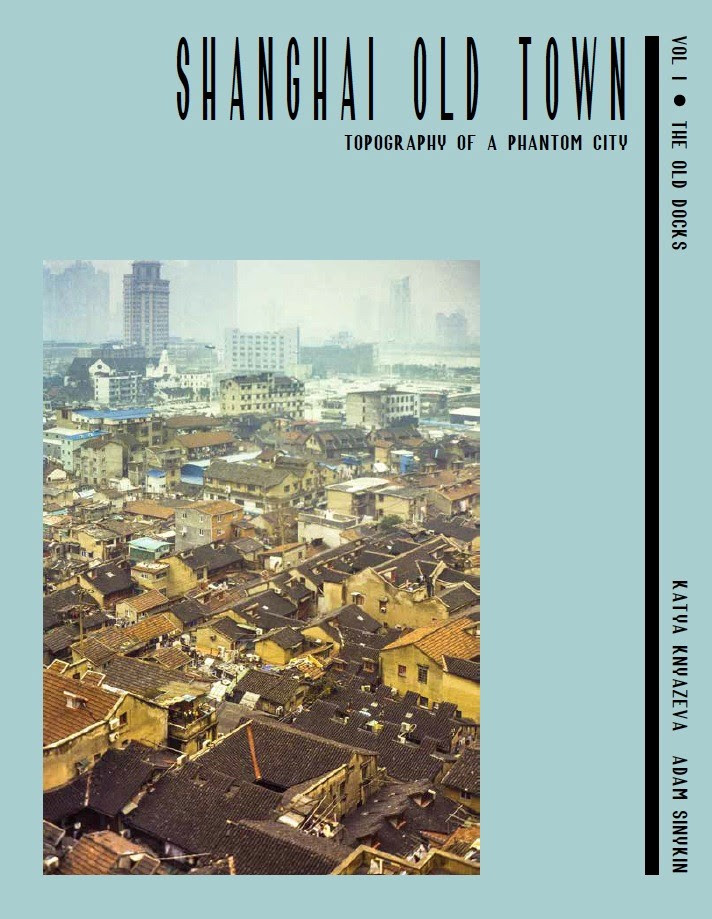Posted: January 22nd, 2016 | No Comments »
RASÂ WEEKENDERÂ
Saturday 23 January 2016
4:00 PM for 4:15 PM start
Radisson Blu Plaza Xingguo Hotel, Tavern Bar
78 XingGuo Road, Shanghai
兴国宾馆上海市兴国路78å·
BOOK LAUNCH
Shanghai Old Town: Topography of a Phantom City
Volume One: The Old Docks
By Katya Knyazeva
Shanghai Old Town is a history and a photographic atlas of the former walled city and port of Shanghai. Volume One: The Old Docks explores the ancient lanes and historic relics of Dongjiadu, the wharves and lanes outside the city wall. The winding streets in this neighborhood tell the story of the region, the trades, the cults and the clans that made Shanghai a merchant capital long before the western powers built the international treaty port.
In spite of half a century of neglect and mounting redevelopment pressure, Dongjiadu retains a dynamic, unregulated street life and the most varied urban fabric. But the neighborhoods are being erased. The Old Docks is a survey and an epitaph of a city on the verge of disappearance.
Katya Knyazeva is a journalist and photographer from Siberia. She has been living in Shanghai since 2006, where she worked variously as an illustration artist, writer, photojournalist and historian. She has published articles on Chinese cuisine, arts and theater, urban form and Shanghai history. She has been a speaker at Explore Shanghai Heritage, the Royal Asiatic Society, Shanghai Expat Association and World Art Deco Congress. She is the author of
Shanghai Old Town: Topography of a Phantom City (Suzhou Creek Press, 2015).
Talk Cost: RMB 70.00 (RAS members) and RMB 100.00 (non-members). Includes glass of wine or soft drink. Those unable to make the donation but wishing to attend may contact us for exemption.
Membership applications and membership renewals will be available at this event.
To RSVP:Â Please “Reply” to this email or write to
RAS Bookings at: bookings@royalasiaticsociety.org.cn
Posted: January 21st, 2016 | 2 Comments »
I picked up an old 78rpm record recently by Pickard’s Chinese Syncopators called Flower of the Orient, a rather charming Oriental Fox-trot from 1928. Who were Pickard’s Chinese Syncopators?

Well, it seems they were one of a host of Chinese-themed American vaudeville acts of the 1920s, though at some point they spent some time in London and did record in England too. They weren’t Chinese, there were usually about eight of them, and they were probably mostly Filipino musicians. They were a mandolin band (with some Hawaiian guitars and banjos), which was pretty popular at the time and usually appeared wearing Chinese robes and mandarin hats – after a fashion. They were quite prolific and some of their hits include:
You Told Me To Go
Stay Out of the South
Ali Baba
Gypsy Dreams
China Lily

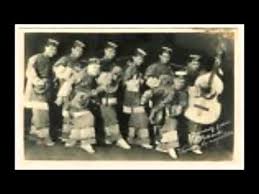
They made it into the movies too – if only briefly with the 1931 short movie Singapore Sue. This was shot in New York and featured two popular Chinese-American vaudeville acts Joe Wong and Anna Chang. A bunch of white American sailors walk into a Singapore dive bar where Joe and Anna are entertaining. The film would probably be completely forgotten if it weren’t for the fact that the uncredited “Sailor No.1”, who tries to pick up Chang, is Cary Grant – the first time he appeared on film and the first time he used Cary Grant rather than Archie Leach, his original name and which he’d kept when he first went from Bristol to America to try and make a career on Broadway.

Posted: January 20th, 2016 | No Comments »
Sue Anne Tay of the excellent Shanghai Street Stories blog brings sad news of the destruction of the former Bridgman Memorial School (裨文女ä¸). As she notes the Bridgman was, “Shanghai’s first girls’ school was founded by missionary Elijah Coleman Bridgman (1801-1861) in 1843. The most famous alumnae was the mother of the Soong Sisters, Ni Guizhen (倪桂ç)(1869-1931). Ni was known to be a bright and bold woman, never had bound feet and spoke English. Now you know how her daughters came to be. Ni’s own mother Lady Xu was a descendent of Ming dynasty mathematician and Jesuit concert Xi Guangqi (å¾å…‰å¯). In Chinese, the building was first called ä¸Šæµ·ç¬¬ä¸€æ‰€æ•™ä¼šå¥³ä¸ (Shanghai’s first Protestant school) or è£¨æ–‡å¥³ä¸ (biyi nvzhong). Located on a small road Xinlinhou Lu(西林åŽè·¯) by Fangxie Lu (方斜路) near Laoximen (è€è¥¿é—¨) area.”
To add a bit – Bridgman was an American Protestant Missionary who founded the groundbreaking missionary run journal The Chinese Repository (about which there’s a lot in my Through the Looking Glass book). He was also later an editor of the Royal Asiatic Society’s North China Branch journal (i.e. the Shanghai based branch of the RAS back then). Arguably it was actually Bridgman’s wife, Eliza Jane (nee) Gillett, an American Episcopalian missionary who founded the school. After her husband’s death she moved to Peking, secured substantial property and started Bridgman Academy, noted for educating a large number of Chinese women leaders.
The school was just outside the French Concession on what was then Fong Zia Road (now Fangxie Road), close to the West Gate (Laoximen and officially the Gate of the Ritual Phoenix) and Dah Ling Road (now Xinlinhou Road). The West Gate was torn down sometime around 1912-14. The school was torn down just recently….



Posted: January 19th, 2016 | No Comments »
It’s well known that Charlie Chaplin spent one day (or a little less than a day, more an evening and night) in Shanghai in 1936 (if you don’t know about it the story is told here rather well). What I think is less well known is that he once considered chucking in the moving pictures business and retiring to China. He didn’t obviously, but he apparently, according to himself did consider it.
Chaplin tells the story in his autobiography entitled “My Autobiography”. In 1931 Chaplin had completed City Lights and decided to sail from America to London for the English premiere. He then opted to travel through Europe and head to Asia via the Suez Canal stopping at India, Singapore, Bali and a few other places to get to Japan, which had long fascinated him (indeed had done so since he read one of Lafcadio Hearn’s books about Japan). After Japan, Chaplin sailed back to America on a ship that did dock at Shanghai, but Chaplin chose not to leave the ship. He eventually got back to Hollywood.
Chaplin was not happy in Hollywood in 1932 describing himself as “…confused and without plan, restless and conscious of an extreme loneliness.” He was single and found California a “graveyard“. He was living in a big house, a star, but dining alone each night. He found Hollywood Boulevard and its stores depressing and drab, in the grip of the Great Depression. He writes: “As I walked the boulevards I began to deliberate whether I should retire, sell everything and go to China.”
Chaplin was heartened by Roosevelt’s victory in the 1932 presidential election but still thought he might just up and head East away from it all – “I still toyed with idea of pulling up stakes and settling in China. In Hong Kong I could live well and forget motion pictures, instead of languishing here in Hollywood, rotting on the vine.”
But he never did. What changed his mind? Basically Paulette Goddard – he met her, fell in love and decided to get back to work. So he never did retire to China though he did visit in 1936 briefly with Goddard in tow. She got him back to work and back into Hollywood though they separated after The Great Dictator.
 Chaplin and Goddard – if not for her Charlie might have ended up a Hongkonger or a Shanghailander
Chaplin and Goddard – if not for her Charlie might have ended up a Hongkonger or a Shanghailander
Posted: January 18th, 2016 | 3 Comments »
I don’t really review books on contemporary China on this blog but I will mention Nick Holdstock’s China’s Forgotten People: Xinjiang, Terror and the Chinese State – primarily because (apart from being a good and insightful study of the Chinese colonial experience in Xinjiang and the simmering resentments and resistance by the Uyghur people of the East Turkestan region) it does mention the horrific and wanton destruction of Kashgar.

The recent, almost total destruction of old Kashgar (3,000 years old and mentioned by Marco Polo) was preceded by decades of slow destruction. At first, after “liberation”, by the destruction (as in some cities across China from Kashgar to Zhangjiakou (Kalgan)) of the ancient city wall. Still, apart from a hideous statue of Mao not so much changed until the twentieth century. Watch The Kite Runner movie and that’s Kashgar standing in for Afghanistan. The destruction of the old town was couched in terms of modernisation and protection against earthquakes (which there haven’t been) but was, as Holdstock indicates, really about punishing Uyghurs for resistance and the reinforcement of Kashgar and all Xinjiang as a mono-cultural state, i.e. Chinese with all vestiges of Uyhgur culture eradicated. One interesting fact about the demolitions of the old town I did not know was that the Communist Party erected billboards indicating that UNESCO approved of the destruction.

Kashgar – before the bulldozers really got to work
And, of course, old Kashgar was doomed because nobody, at least nobody connected to the CCP, was profiting from it. Of course with all land in China, including its occupied regions such as Xinjiang, owned by the state (Communist Party) then pulling down to rebuild is profitable for the state in an immediate way preservation, heritage restoration and improvement of existing traditional architecture is not. So old Kashgar got bulldozed – Uyghur culture was diluted, Chinese state control of the region (arguably) strengthened and the Party made a profit. Of course, as Holdstock points out, being “Han” Chinese (used in the sense of the ethnically catchall term it is by most Chinese, Han or otherwise) doesn’t help much as hutong and lilong dwellers in Beijing and Shanghai respectively know only too well.


Posted: January 17th, 2016 | No Comments »
Silver Cabs is probably the best known and most often recorded taxi cab firm in old Shanghai memories – Du “Big Eared Du” Yuesheng owned it reputedly. But Ford Taxis were also big in the business between the wars. The Ford Hire Taxi Company (just call Shanghai 30189) had one distinctive feature – rather than ordinary horns the cars all had very loud klaxons, little boxes mounted just outside the drivers side window. there was a piston type switch on the top of the box and to operate it the driver leant out and depressed it. the noise was a typical klaxon sound but did make people jump and get out of the way – really, really bad pedestrian behaviour, poor driving, jay walking and generally being an idiot on the road is nothing new to Shanghai!
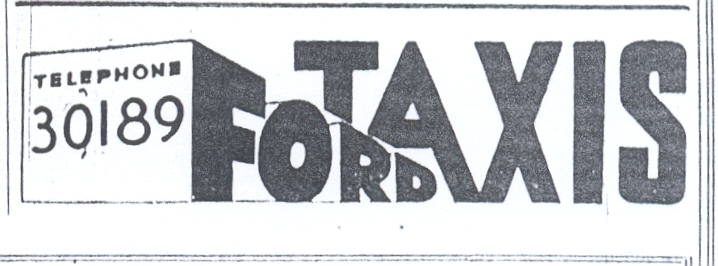
Posted: January 16th, 2016 | No Comments »
I wrote a piece last year for the Asia Literary Review (issue 29) on the old rooftops of Shanghai (you can get it here on kindle or hard copy). In that article, which comes with some good pictures and old advertising ephemera. Of course you always find the photo you wanted but couldn’t locate too late!! Came across this favourite old picture from 1937 of two very stylish Shanghailanders watching the skies for the fighting over to the north. No idea who these two Settlement Bohemians are – a plaid coat and a white trilby worn just so are amazing! The picture is by the inimitable Sam Tata and he titled Rooftop Watchers.
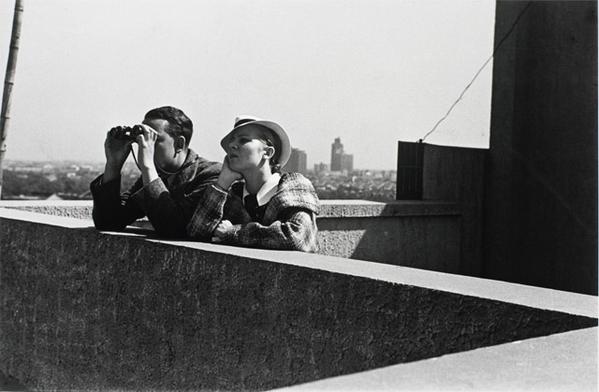
Posted: January 15th, 2016 | No Comments »
My thanks to Doug Clarke – author of the excellent Gunboat Justice trilogy – for this picture of Carl Crow, with two of his bandit helpers, at Lincheng in Shandong in 1923. Bandits had taken foreigners and Chinese hostage from a train; Carl Crow, on behalf of the Red Cross, was sent in to negotiate. It’s a great story and I attach it below as an excerpt from my biography of Crow, A Tough Old China Hand. What a great photo!!
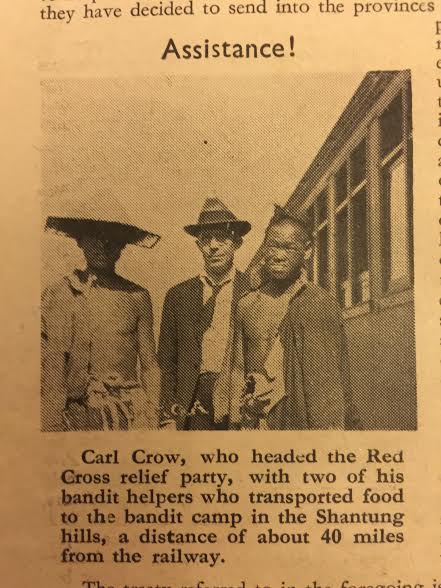
Becoming a Warlord’s Elder Brother
Of all the warlords Crow met the one he actually struck up a friendship with was the twenty five year old ‘Commander in Chief’ Swen Miao. In Crow’s own words Swen was ‘a real throat slitting bandit of the sort that splash blood on the pages of fiction and sometimes get into Hollywood.’ Crow and Swen’s friendship reached the point where Crow sent cartons of cigarettes to him while the warlord sent Crow bottles of brandy, though Crow noted that while he paid for the cigarettes the brandy was undoubtedly part of the bandit’s swag from some looting expedition. The two eventually got to the point where Swen referred to Crow as dage, or elder brother. A rare privilege indeed.
The story of how Crow got to be such good friends with a bandit warlord was a major news story in Shanghai at the time. Swen was one of China’s best-known and most notorious bandits in the 1930s and made the front pages of newspapers as far afield as London and New York. Crow’s description of him as throat slitting doesn’t sit with the fact that Swen spoke English, was considered patient by his hostages and generally thought to be a good and kind leader of his men – JB Powell called him a ‘young chap…from a formerly respected family’. He had also received military training in the army of Chang Ching-yao, the pro-Japanese warlord who had taken control of Beijing briefly in 1920.
However, in the intervening decades Swen has largely been overshadowed in history by Chang Tso-lin, who was assassinated by the Japanese when his train was blown up in 1928 after forming an alliance with the Nationalists. Crow was forced to admit that Swen slipped pretty quickly from history: ‘He was not, however, a very successful bandit, for he was young and more ambitious than practical; but he might have travelled far after he had gained more experience if he had not been beheaded before he reached the prime of life.’
In fact Swen’s story was fairly typical of many bandits in China. He had come from a successful family who had managed somehow to annoy a local magistrate with their progressive political ideas. His father had ended up losing his head after a show trial on trumped up charges. The magistrate then made every police station in the family’s home province of Shandong exhibit photos of the execution and Swen was smart enough to realise that someone this obsessed with destroying his family would come after him next. So he wisely took to the hills with a few other endangered relatives and sought revenge on the magistrate. As Crow noted, ‘The Chinese learned many centuries ago that crooked officials can never be reformed and that the only practical thing to do is to kill them.’ At least that was the biography of Swen Crow believed. An alternative, somewhat less romantic version, has it that the Swen clan fell on hard times after idle, gambling sons squandered the family’s wealth and so became salt smugglers and bandits.
Whichever was the true story soon Swen had over 700 followers as his ranks swelled with men following the Yellow River flooding in 1920 and 1921 ruining many peasant farmers. Swen initially had a good stock of arms purchased with the proceeds of raids and robberies. However, the local population didn’t care that much as Swen mostly raided police stations or ambushed armed police detachments patrolling the countryside. As their loot grew many disaffected soldiers fed up with low pay and meagre rations joined Swen. Poor peasants worked their farms and then when the harvest was finished would disappear for a little banditry until farm work called them back to their land. Swen moved on to raiding rich landowners and became a Robin Hood figure for many peasants and perpetuated this myth of being an active agent of redistribution by naming his gang the Shantung People’s Liberation Society. All the time he kept on trying to assassinate the original corrupt magistrate who had killed his father though the man kept a loyal force of bodyguards that made the job difficult. As time passed so the Shantung People’s Liberation Society grew still further in a loose way with more bandits joining the ‘cause’.
Eventually the Liberation Society set up a semi-permanent camp on the slopes of Paotzeku Mountain, which was virtually unassailable from below. Swen continued raiding and kidnapping to the point where his reputation grew to such proportions that he rarely needed to leave camp and local merchants and wealthy landowners started paying him tribute and tolls (lijin) as protection money to leave them alone. The magistrate and his forces rarely entered Swen’s territory. It was a stand off between the secure Swen and the well-guarded magistrate.
This situation could presumably have carried on indefinitely to both men’s benefit had Swen not decided on 6 May 1923 to attack the nearby Tianjin-Pukow Railway and derail the new deluxe fast train that plied the route between Shanghai and Beijing, the Blue Express – the first all-steel train in Asia. Swen, and a thousand of his followers, kidnapped all the passengers in the early hours of the morning and looted the train near the town of Lincheng close to the Jiangsu-Shandong border (though technically in Hebei province) leading to the whole crisis becoming known as the Lincheng Outrage. His hostages included 300 Chinese and, crucially, 25 foreigners (foreigners generally fetched larger ransoms). The train was ransacked, all valuables taken and even the mattresses and light bulbs stripped by the bandits as loot.
One short-term hostage was First World War veteran and China Press journalist Lloyd Lehrbas who managed to escape and started filing stories about the incident almost immediately. Consequently the news that foreigners had been kidnapped from the Blue by a warlord and that a ransom was being demanded greatly excited the greatly excitable Shanghai foreign community many of who saw visions of Boxer-like retribution and killing returning. To the insulated residents of the International Settlement Chinese warlords terrorising and kidnapping Chinese citizens was one thing but terrorising and kidnapping westerners was quite another thing altogether. Though the kidnapped were probably relatively safe on the grounds that dead hostages were worthless it was not unknown for prisoners to be slaughtered wholesale by warlords. The bandit soldiers were a mixed bunch and included poor farmers and unemployed youth from the ‘university of the forest’ as well as a hard core of battle trained soldiers who had seen action in Russia and Korea as well as China but had been discharged from the Chinese army and were aggrieved at their loss of status as well as men who had formed part of the 140,000 strong ‘Chinese Labour Corps’ recruited by the British and French during the First World War to do tasks such as clearing the dead from the European battlefields and keeping the trenches supplied. Needless to say these men had seen some of the worst atrocities imaginable, become extremely battle hardened and then sent home with some coppers once their usefulness ended.
In news value terms kidnapping, of either Chinese or foreigners, was not necessarily a shocking event at the time. Crow described kidnapping as a ‘well organised business in China carried out with a large degree of success…’ although kidnapping was still something to be feared. Crow knew that travelling in the hinterland of China between the wars, as he did often, was to put yourself at a certain risk of kidnap whatever precautions were taken. Small comfort was the fact that it was relatively rare for foreign hostages to be abused severely and Crow worried more about lack of food and inclement weather than violent mistreatment.
The rest is in the book…!!
